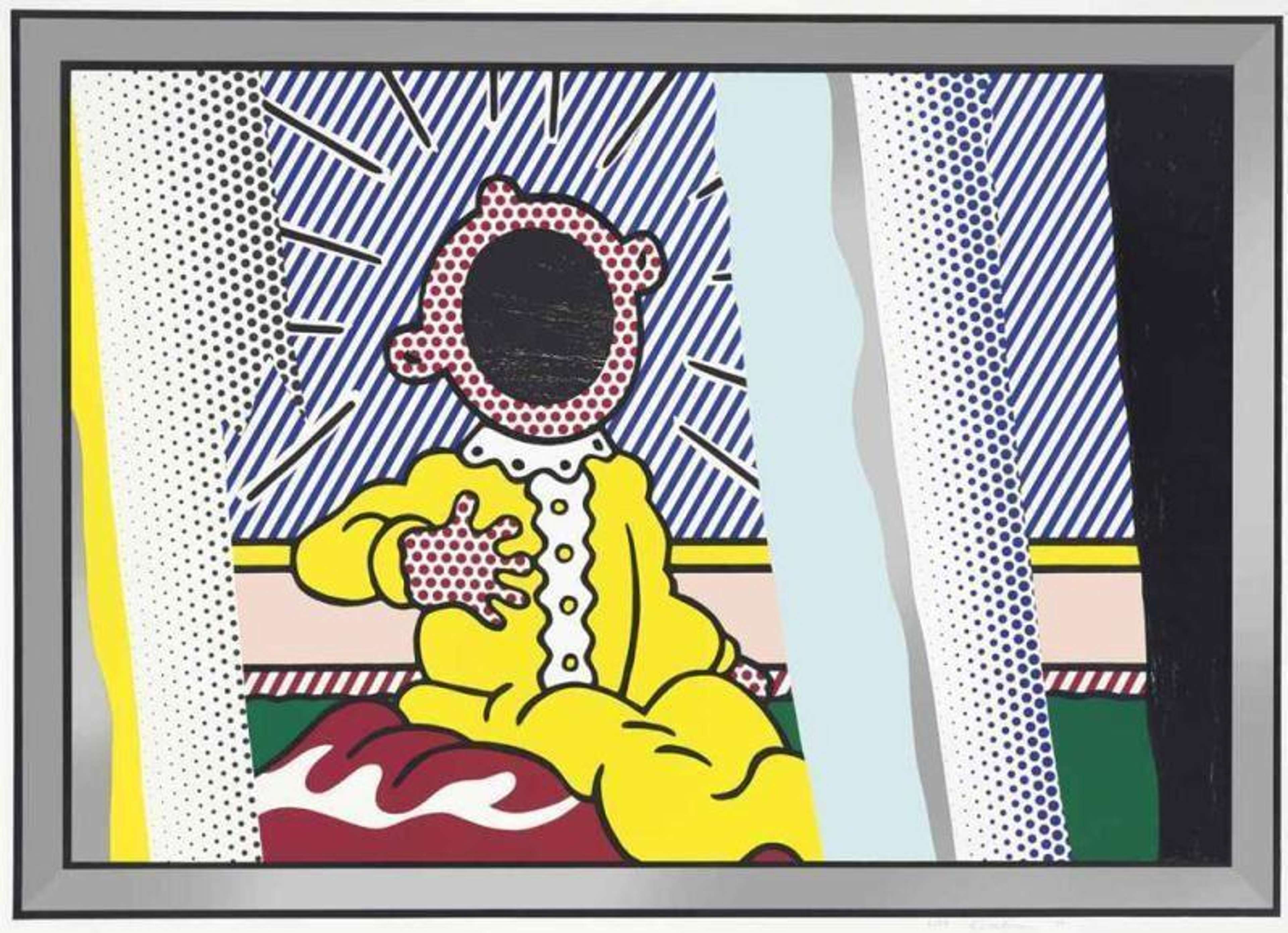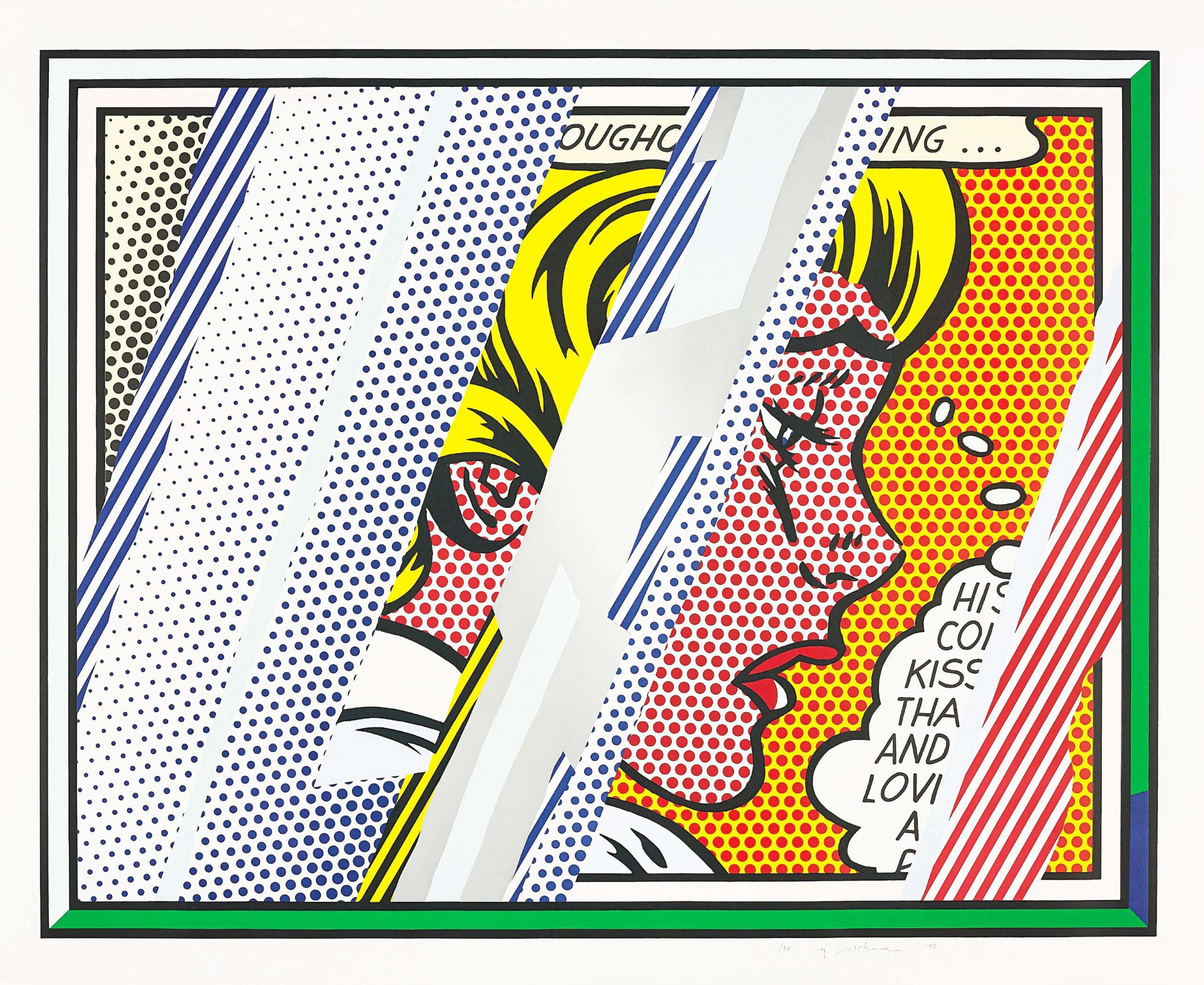 Reflections On The Scream © Roy Lichtenstein 1990
Reflections On The Scream © Roy Lichtenstein 1990
Interested in buying or selling
Roy Lichtenstein?

Roy Lichtenstein
290 works
In Reflections, Lichtenstein appropriates his own artworks, distorting them with reflections. The work toys with the viewer's perception, and calls into question the purpose of art to represent what is seen.
The series toys with ways of seeing.
 Reflections On A Soda Fountain © Roy Lichtenstein 1990
Reflections On A Soda Fountain © Roy Lichtenstein 1990By concealing his original compositions with shards of glass or light, Lichtenstein challenges notions of vision, dimension, and the very purpose of representation. This is something also explored in his Haystack and Cathedral series, where Lichtenstein similarly used his iconic Ben-Day dots almost like optical illusions.
Lichtenstein defaces his own work in this series.
 Reflections On Hair © Roy Lichtenstein 1990
Reflections On Hair © Roy Lichtenstein 1990In Reflections, Lichtenstein appropriates and sabotages his own comic book-inspired works by depicting them through a glass lens, distorting the viewer's vision of them. Though they are defaced, the works are still distinctly Lichtenstein, speaking to the power of his visual language by this point in his career.
The series is not the first time Lichtenstein experimented with light and vision.
 Mirror #8 © Roy Lichtenstein 1972
Mirror #8 © Roy Lichtenstein 1972In the later years of his career, Lichtenstein became increasingly fascinated by abstraction. His Mirrors series, for example, challenged representation and perception by depicting a mirror as a completely two-dimensional object. This was something he took forward into Reflections, using layers to distort the viewer's perception.
The series was created with only four colours.
 Reflections On Minerva © Roy Lichtenstein 1990
Reflections On Minerva © Roy Lichtenstein 1990In true Pop Art spirit, Lichtenstein always attempted to emulate the aesthetic and process of commercial printing. Even in this semi-abstract body of work, Lichtenstein still contained his palette to four colours: red, yellow, blue, and green.
The series parodies Abstract Expressionism.
 Reflections ON Expressionist Painting © Roy Lichtenstein 1990
Reflections ON Expressionist Painting © Roy Lichtenstein 1990Much like his satirical Brushstroke Faces, Lichtenstein parodied the supposed spontaneity of Abstract Expressionism in this series. Lichtenstein proved here that nothing in art is coincidental, and that even flashes of light are represented with careful consideration. In his Reflections On Expressionist Painting, for example, mimics the appearance of a brushstroke with Lichtenstein's industrial printing process, making a mockery of Abstract Expressionism.
The series places heightened emphasis on the viewer's interpretation.
 Reflections On Girl © Roy Lichtenstein 1990
Reflections On Girl © Roy Lichtenstein 1990With graphic shards of glass or light clouding view of the composition, Lichtenstein conceals his subjects in the background of these works. In Reflections On Girl, for example, Lichtenstein conceals the comic strip-inspired text bubble which was so integral to his earlier work. The half-concealing of this text bubble plays, once again, with representation and invites the viewer to ponder what might lie beneath Lichtenstein's painted barrier.
The series mocks the mechanical reproduction of art.
 Reflections On Crash © Roy Lichtenstein 1990
Reflections On Crash © Roy Lichtenstein 1990Lichtenstein's Reflections are pictures within pictures, formed of layers of representation. In this, he parodies the essence of Pop Art, which was built on the basis of reproducing popular imagery. In this series, based on his older works, Lichtenstein perhaps shows how his own imagery had become part of popular visual culture by 1990.
The series was inspired by a body of paintings executed between 1988-93.
 Reflections On Brushstrokes © Roy Lichtenstein 1990
Reflections On Brushstrokes © Roy Lichtenstein 1990The idea for the Reflections series was conceived, at first, in paint. As Lichtenstein himself recalled: "It started when I tried to photograph a print by Robert Rauschenberg. But the light from a window reflected on the surface of the glass and prevented me from taking a good picture."
The prints in the series are technically advanced.
 Reflections On The Scream © Roy Lichtenstein 1990
Reflections On The Scream © Roy Lichtenstein 1990Made at Tyler Graphics in Mount Kisco, New York, the Reflections series is one of Lichtenstein's most technically advanced. The prints in the series were produced using a combination of lithography, screenprint, and relief with collage and embossing.
The series has a renewed relevance today.
 Reflections On Conversation © Roy Lichtenstein 1990
Reflections On Conversation © Roy Lichtenstein 1990Lichtenstein's Reflections series is all about artistic representation and re-representation. The body of work was inspired by Lichtenstein's attempts to photograph a work of art behind glass, something all too relatable to modern smartphone users in a gallery. The series was before its time, and is a significant comment on perception and how we view art to this day.
